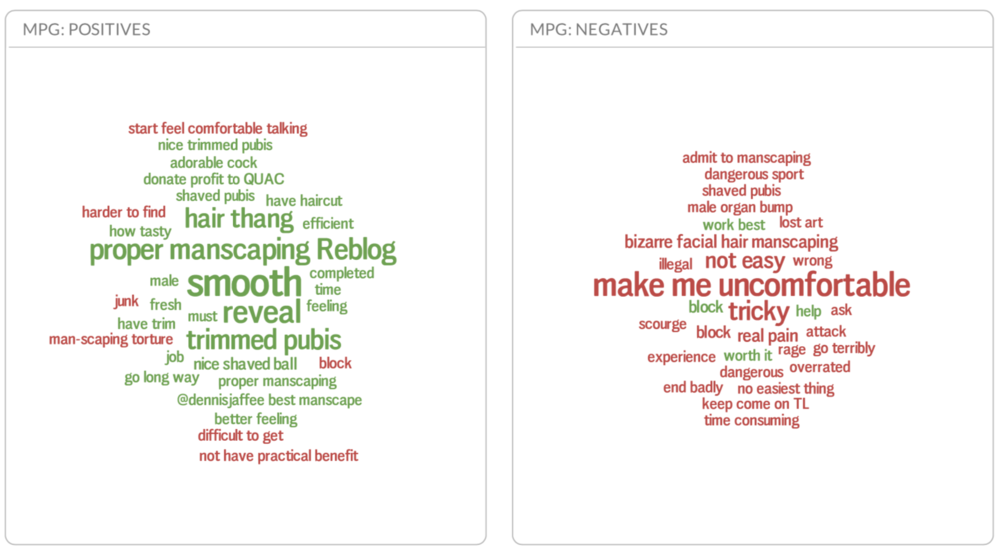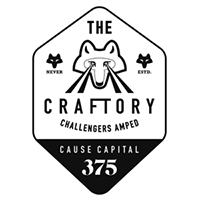Manhood in Therapy
Insights and challenger opportunities from a category in crisis
These aren’t happy days for men. Toxic masculinity, #meetoo and decades of entitlement have finally come home to roost, and what exactly constitutes the right model of masculinity in our woke, enlightened times is a topic of considerable (and refreshing) debate. As new definitions of covetable manhood replace the discredited old, so behaviours are changing – and the towering brand equity of incumbent male brands is crashing down. This leaves the space wide open for an exciting new generation of cause-driven male brands to define our times.
However, understanding exactly what’s driving the zeitgeist in the category is essential for insurgent challenger brand entrepreneurs looking to make the difference. We recognise this at The Craftory, and hence devote considerable resources helping our brands get beneath the skin of shifting consumer wants. This includes shining the voodoo light of advanced sentiment analysis on the world-wide social web[1], which every day brings stunning insights into the live terraforming taking place in the brand world surrounding us.
So, for the benefit of challenger brand entrepreneurs everywhere, here we present 5 of our finer insights into the Nascent Wild West Of Male Brands:
Net Sentiment and Passion score for selected male grooming brands and topics, all internet, Feb 2018-March 2019
1. Gillette is toast.
For decades, Gillette’s multi-blade-tumescent “the best a man can get” dominated the landscape of male grooming brands, virtually unassailably. We all grew up surrounded by Gillette adverts featuring chiselled, steely men longingly caressed by subservient, objectified women. As a brand formula, it ruled for two generations. It also contributed, subliminally, to the core of the toxic, entitled masculinity that has so decisively been rejected today. Gillette’s mealy-mouthed attempt at appropriating the debate around reinvented masculinity with their recent “the best a man can be” campaign smacked of corporate brand-managed apologism – and was resoundingly denounced as such. Sentiment analysis doesn’t lie, and at -17%, Gillette’s net equity is in shockingly bad shape. Gillette is still a formidable brand, but it is now weak, wounded and lacking the bearings to fight back. Step forward the challenger cohort, with honest, no-nonsense Dollar Shave Club a dizzying 75%-points ahead of Gillette on net sentiment, and winning by a stunning 20%-points on passion. “The best a man can get” looks decidedly out for the count.
Gillette sentiment drivers (red: negatives, green: positives), all internet, Feb 2018 - March 2019
2. Branded generics are the new black.
The shape of emerging neo-manhood is consciously vulnerable, which is in many ways the antithesis of Gillette’s unflinching virility. With that vulnerability comes recognition (rather than denial of) male gender weaknesses – baldness, erectile dysfunction, anxiety, greying skin - and the desire to do something about them. A coterie of challenger brands (Hims, Roman, Manual, amongst others) are all setting out to tackle this recognition of gender weakness by offering re-packaged, age-old generics (Minoxidil, Viagra, Propranodol) under neo-manhood-friendly, it’s-ok-to-be-vulnerable branding… and at premium price. Hims is the poster child amongst this new breed of self-medication male brands - igniting considerable passion in debate, and praise for “making it easy” to tackle male problems. However not all of sentiment is good – with plenty of consumers questioning the value of paying more for generic drugs just because they’re branded in a zeitgeisty way. At The Craftory, we think the Hims/Roman/Manual approach is a problematic response to a genuine emerging male need. We’d rather see the acceptance of male problems be met either with disruptive innovation, or democratising access to trusted remedies.
Hims sentiment drivers, all internet, Feb 2018 - March 2019
3. Pubic Grooming is The Big Thing no-one dares to mention.
For any man over 40 this might sound like a farce, but fact is, the modern gent grooms his pubes. And don’t be fooled into thinking this happens only by exception. A full 85% of men under 35 shave or trim their pubic hair – meaning that more men engage in “manscaping” their pubes than shaving their beards. Let that sink in for a moment. The sentiment and passion around pubic grooming is also higher than that for facial grooming – and it spikes to a remarkable 100% net score when consumers refer to it in the emotionally vulnerable context of dating and romance. So male pubic grooming is an important and widespread behaviour. However, look at the amount of conversation male pubic grooming commands on social media, and it is tiny. There’s 20x more talk about men shaving their beards. Paradoxically, then, pubic grooming is both thoroughly mainstream in adoption, and resolutely taboo in conversation - because no mainstream brand has found the right tone or angle to make it possible for male pubic grooming to be spoken about openly. A new generation of challenger brands aim to right this wrong, with the aptly-named and skyrocketing Manscaped standing alongside Below The Belt Grooming and Mangroomer, amongst others. Despite the early successes, pubic grooming remains a huge opportunity and largely virgin territory for challenger brands.
Male Facial and Male Pubic Grooming - topic sentiment and passion filtered for context of first date / first kiss / first partner - all internet, February 2018 - March 2019
4. Men are seeking help, role models, and guidance.
One of the defining characteristics of this formative period in neo-masculinity is that men are openly confused about how to act, what routines to follow, and what tools to use. A lot of the sentiment around male grooming revolves on the theme of wanting help: expressing insecurity, looking for guidelines, needing reassurance and support. This calls for role models to step forward, and for the debate to focus on thoughtful advice around how to be a man in the 2020s. Already influencers are taking on this job, as can be seen by the sentiment, passion and volume of conversation dedicated to pubic grooming amongst opinion-leaders online, as opposed to the population as a whole. Brands, however, can play an important part in building trust and confidence in behaviours, especially when trust in the incumbents is gone – which is where the field remains wide open for budding challenger brands.
Male Pubic Grooming (MPG) topic sentiment drivers, all internet, February 2018 - March 2019
5. It’s crickets on the cause front.
The hallmark of successful challenger brands is that they are champions of a burning righteous cause, reflecting our zeitgeist, as their reason for being. At The Craftory, we’ve identified 5 big themes that define our times – around progressing sustainably in tune with the planet’s resources, democratising access, progressing society, unlocking good health, and – particularly important in personal care for a generation daily fed impossible images of body and lifestyle on social media - championing self-esteem. When measuring sentiment around brands, we regularly see social conversation spike around one or more of these 5 core themes for winning challenger brands – and very little of it for the corporate incumbents. It’s an objective measure of the relevance of a challenger how much they succeed in owning the debate around a big theme core to their category. Shockingly, it’s crickets on the cause front for all of the brands in male grooming. Hims come closest, with a clear 11% spike around Deliver Good Health – but for the rest, it’s silence. It’s especially striking that no male grooming brand scores anything remotely meaningful on the cause of Champion Self Esteem, even though this is the evident gap for personal care. This is a huge, yawning, wide open wrong waiting for purpose-driven challenger brands to right.
Share of conversation by theme, all internet, February 2018 - March 2019
Times of change are times of growth. Few categories are undergoing an introspection quite as searching, and a redefinition quite as profound, as that of male grooming and personal care. There’s a world of opportunity waiting for gutsy challengers to grab. We’re far from the endgame yet, and epoch-defining brands will rise in the coming months and years that stand to take over from where Gillette stepped down. At The Craftory, we’ll be watching closely, and we’ll be there to help the new generation win, with insight and skill, the challenger way.
[1] As part of our capability set, The Craftory uses tools that scrape every public mention of definable topics, brands or themes across Facebook, Instagram, Twitter, Reddit, YouTube, Tumblr, news sites, reviews, blogs and forums, plus the world-wide web, and then analyses them with 3rd-generation natural language processing to extract underlying sentiment. In any language. Voodoo indeed. Just more insightful.
Ernesto Schmitt is co-founder at The Craftory, the brand-new counter-corporate anti-VC on a $300M mission to back the world's boldest insurgent challenger brands in the consumer goods space.








